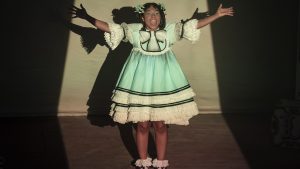
Along with being one of my favorite games of the year, Alan Wake 2 is one of the best horror games in quite some time. It’s brimming with personality that feels true to its creators, it’s scary without being overwhelmingly terrifying, its narrative is genuinely compelling, and, for whatever this may be worth to you, it’s achingly beautiful.
However, one of the most fascinating things about Alan Wake 2 is how it handles a debate that has recently divided the horror gaming community: the “Yellow Ladder” problem.
If haven’t gotten swept up in that particular online argument just yet, the yellow ladder debate most commonly refers to a design decision heavily featured in the recent Resident Evil 4 remake. In that game, many ladders (and certain other objects) are splattered with yellow paint or covered in yellow tape.
Why? Well, there’s not always an obvious narrative reason, but from a game design perspective, those objects are designed that way in order to quickly inform players that they can (and often should) be interacted with. While the Resident Evil 4 remake is the most recent example of that design concept, it’s actually surprisingly common in most modern games. The color yellow is often used to guide players through video game worlds and shine a light on the way forward.
For as common as that design decision is, some gamers clearly take issue with it. The most extreme examples of the argument against yellow ladders (the shorthand for this discussion I’ll be using from now on) say that it’s just lazy video game design that only benefits those who are otherwise unable to figure things out on their own. Others say that the yellow ladders aren’t necessarily a problem, but they do take issue with those games that utilize that concept in ways that break the intended environmental immersion.
On the other side of this debate are those who either enjoy the helping hand that yellow ladders provide or simply find them to be a necessary evil. In fact, some game designers weighed in on this debate to argue that yellow ladders are the smallest compromise that could have been made to address a bigger issue.
Again, though, it’s important to remember that the yellow ladder debate is also a symptom of a larger argument about games that arguably lend too great (or too obvious) of a helping hand. For instance, God of War Ragnarök recently triggered a similar debate over its very generous help system that would often spoil the solution to puzzles before most players had a chance to solve them.
So how does Alan Wake 2 handle the yellow ladder debate? Well, it does still sometimes utilize its own versions of yellow ladders. Certain collectible items are clearly marked by a recurring object, and there are multiple instances when arrows will help guide you along your path. I’ll argue that the game does a better job than most of incorporating those guiding objects from a narrative standpoint, but they’re certainly still there.
However, Alan Wake 2 doesn’t always lend you a direct helping hand. There’s no modern in-game hint system option, characters rarely (relatively speaking) directly guide you to solutions via repeated voiceovers, and most ladders are…umm…ladder colored, I suppose. The game often relies on you to figure a lot of things out.
It’s clear that style of game design is not for everyone. Quite a few people are already confessing that they often find themselves lost in Alan Wake 2, and I honestly think much of that confusion is warranted. The game’s map doesn’t always do a great job of conveying where you can and can’t go, and there are times when the correct path forward is essentially “hidden” in ways that feel unintentional. Yes, it turns out that some ladders are yellow for good reason.
For the most part, though, I find Alan Wake 2‘s approach to the modern video game “hint” system pretty refreshing. With some exceptions, most of the confusion you will encounter in Alan Wake 2 occurs when you’re trying to navigate an optional part of the game. The idea seems to be that if you’re willing to venture off the game’s beaten path, you should encounter challenges that represent your inherent willingness to explore. While the game’s puzzles are relatively easy in the grand scheme of things, they at least make you pause and look for answers that often happen to be in the immediate area.
Alan Wake 2 is a horror game, and horror games are often more dependent on effective environments than most other titles. In order to build its environment, Alan Wake 2 uses every part of the genre buffalo. For instance, many modern horror games make you collect parts of a map, but many also let you easily ignore them. Alan Wake 2 often makes you consult your various maps. Many horror games feature various signs built into their environments and other repeated landmarks. Alan Wake 2 makes you use those signs for the same reasons those signs logically exist in those areas in the first place. When it comes to establishing its environment, Alan Wake 2 takes nothing for granted and makes the most of so many ideas that would feel superfluous in other games that resort to more direct “gamified” means of navigation.
By forcing you to engage with its environments, Alan Wake 2 not only allows you to experience its many pieces of environmental storytelling in more organic ways, but it often manages to scare you despite not actually doing anything overtly scary. Feeling lost is an inherently terrifying experience, and so much of the tension in Alan Wake 2 comes when you’re looking around in the woods and just hoping that something isn’t going to jump out at you while you’re figuring out where to go. Not all of those moments are paid off with jump scares, but that’s okay. The constant tension that results from that uncertainty is plenty effective on its own.
Alan Wake 2 really forces you to retrain your modern gaming brain and ask yourself where you could go and what you can do rather than where you should go and what you should do. Eventually, it does want you to get up that ladder. However, the time you spend figuring that out isn’t always wasted time; it’s part of the intended experience.
Again, the game is certainly not perfect in that respect. As is increasingly becoming the case in this age of accessibility, the solution to the yellow ladder debate probably lies in those options that Alan Wake 2 largely lacks. Being able to modify how often a game helps you, and how it does so, is one of those things that will hopefully become more standard as gaming accessibility options continue to evolve. Alan Wake 2 could certainly do a little more in that area.
But at a time when yellow ladders are becoming an increasingly accepted part of the modern gaming experience, I’m glad Alan Wake 2 offers a necessary counterpoint by illustrating the benefits of not always relying so heavily on that solution. Sometimes, being lost is exactly where you’re meant to be.
The post How Alan Wake 2 Navigates Gaming’s “Yellow Ladder” Debate appeared first on Den of Geek.






